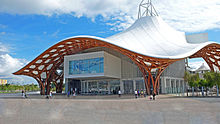Shigeru Ban
[4] The Pritzker Jury cited Ban for his innovative use of material and his dedication to humanitarian efforts around the world, calling him "a committed teacher who is not only a role model for younger generation, but also an inspiration.
Hejduk, the most experimentally minded of the New York Five,[citation needed] had a lasting influence on Ban, whose work reflects continuing explorations into basic geometric elements.
[citation needed] Ban's formal explorations with basic building materials helped to lead him into unique structural solutions.
Hejduk's rationalist views on architecture provided a way of revisiting Western modernism and gaining a richer appreciation than the reductive vision of it as a rationalized version of the traditionalist—yet ultra-modern—Japanese space.
As a result of this, Ban's DIY refugee shelters (used in Japan after the Kobe earthquake, in Turkey, Rwanda and around the world) are very popular and effective for low-cost disaster relief-housing.
[5] Ban created the Japanese pavilion building at Expo 2000 in Hanover, Germany in collaboration with the architect Frei Otto and structural engineers Buro Happold.
Natias Neutert, German thinker, critic, and poet, marks Ban in his essay as "a gentle revolutionary ... guiding contemporary architecture towards transparency, the spherical and the open".
The structures are most commonly available from manufacturers providing paper tubes for use in textile factories, as in the case with the disaster relief shelters project in Ahmedabad, India.
[11]pg29 Limited material availability during times of disaster relief reconstruction is a major concern and involves increased market prices.
Paper tubing also proved advantageous for building emergency shelters during the Rwanda refugee crisis in 1994, where the use of trees for framing was creating deforestation problems, and alternative construction materials were difficult to find.
[11]pg30 Switching to paper tubing for frames helped save money, prevent theft and conserve the local trees.
Ban's paper tube shelter design from Rwanda's Byumba Refugee Camp was featured in a PBS NewsHour story.
[13]pg173 Not only are the temporary shelters very cheap and easy to develop as they incorporate community participation, but they offer more versatile living conditions compared to traditionally used tents.
[11]pg32 In addition, the 6-foot (1.8 m) paper tubes were waterproofed with liquid urethane to minimize expansion and contraction due to humidity variances found in Osaka-Cho Japan.
Ban's design allowed for full recyclability of the Japanese Pavilion, in keeping with Expo 2000's theme of environmental awareness.






